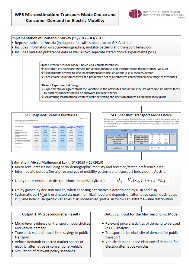Microeconomic Analysis - DEFINE
Main menu
Microeconomic Analysis
This section comprises 2 work-packages. The main beneficiaries are CASE, DIW and IHS.
1. Survey and Estimation of Consumer Patterns and Elasticities (WP3)
Objectives
Implementation of a representative household survey on mobility behaviour in Austria including stated preference experiments on transport mode choice and consumer demand for electric mobility
Descriptive analysis of mobility patterns, needs and expectations of consumers towards alternative transport modes and drive technologies
Microeconometric evidence on transport mode choice and vehicle demand in Austria with special emphasis on electric mobility (including e.g. willingness to pay for various attributes and value of travel time savings)
Simulation of vehicle market shares and transport mode split in base and alternative scenarios developed in WP5
Provision of price-demand-elasticities and other fundamental data to be included in the computed general equilibrium model developed in WP1
Description
Task 3.1: Survey Design
Includes a survey on mobility behaviour, stated preference experiments on mode and vehicle choice and micro-estimation of willingness-to-pay, needs and expectations of consumers towards alternative transport modes and drive technologies. It provides price-demand-elasticities to be included into the general equilibrium model.
Task 3.2: Survey Realisation
A subcontractor, namely GfK Austria will fulfill this task. He recieves the definite experimental design from IHS and includes both the genereal survey questions and the experiments in an online-survey. After achieving the sample size agreed upon the data are handed to IHS, including weights for every person in order to obtain results that are representative for Austria.
Task 3.3: Micro-estimation
This task entails the development of two seperate mixed multinomial logit models with alternative-specific and individual-specific variables as predictors: One focussing on puchase decisions in the vehicle market and another focussing on transport mode choices.
Task 3.4: Providing Behavioural Parameters for the hybrid general equilibrium model
Using the estimations fo task 3.3 we provide behavioural parameters to be implemented in the model derived in WP1. Price-demand-elasticities between public and individual transport and between different vehicle types.
2. Analysis of Polish households for low carbon vehicles (WP8)
Objectives
Identification of determinants and barriers of purchase of low carbon vehicles in one post-transition country, Poland.
Analysis of the demand of Polish households for low carbon vehicles and examination of variability in car use of different fuel type vehicles.
Analysis of usage patterns of alternative transport modes across Polish households,
Estimation of willingness-to-pay for specific attributes of passenger vehicles in Poland
Provision of parameter of household demand for vehicles for macro models developed in WP1, WP6 and WP7.
Description
Task 8.1: Analysis of household demand for low carbon vehicles and transport modes in Poland
The analysis focuses on modelling the decisions made by Polish households on car ownership and type of car. Both questions will be examined using economic and socio.psychological approaches. The aim is to predict sonsumers' purchasing behaviour. First, available statistics on passenger car penetration within households will be reviewed. Second, determinants and barriers of purchase of low carbon vehicles will be identified. Choice experiments will be conducted to reveal main determinants of low carbon vehicle purchases. Quota sampling will be used to draw a representative sample of the Polish adult population.
INSIDE the
WORKFLOW
